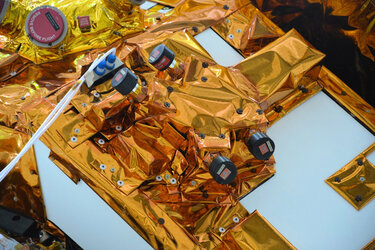Accept all cookies Accept only essential cookies See our Cookie Notice

About ESA
The European Space Agency (ESA) is Europe’s gateway to space. Its mission is to shape the development of Europe’s space capability and ensure that investment in space continues to deliver benefits to the citizens of Europe and the world.
Highlights
ESA - United space in Europe
This is ESA ESA facts Member States & Cooperating States Funding Director General Top management For Member State Delegations European vision European Space Policy ESA & EU Space Councils Responsibility & Sustainability Annual Report Calendar of meetings Corporate newsEstablishments & sites
ESA Headquarters ESA ESTEC ESA ESOC ESA ESRIN ESA EAC ESA ESAC Europe's Spaceport ESA ESEC ESA ECSAT Brussels Office Washington OfficeWorking with ESA
Business with ESA ESA Commercialisation Gateway Law at ESA Careers Cyber resilience at ESA IT at ESA Newsroom Partnerships Merchandising Licence Education Open Space Innovation Platform Integrity and Reporting Administrative Tribunal Health and SafetyMore about ESA
History ESA Historical Archives Exhibitions Publications Art & Culture ESA Merchandise Kids Diversity ESA Brand CentreLatest
Space in Member States
Find out more about space activities in our 23 Member States, and understand how ESA works together with their national agencies, institutions and organisations.
Science & Exploration
Exploring our Solar System and unlocking the secrets of the Universe
Go to topicAstronauts
Missions
Juice Euclid Webb Solar Orbiter BepiColombo Gaia ExoMars Cheops Exoplanet missions More missionsActivities
International Space Station Orion service module Gateway Concordia Caves & Pangaea BenefitsLatest
Space Safety
Protecting life and infrastructure on Earth and in orbit
Go to topicAsteroids
Asteroids and Planetary Defence Asteroid danger explained Flyeye telescope: asteroid detection Hera mission: asteroid deflection Near-Earth Object Coordination CentreSpace junk
About space debris Space debris by the numbers Space Environment Report In space refuelling, refurbishing and removingSafety from space
Clean Space ecodesign Zero Debris Technologies Space for Earth Supporting Sustainable DevelopmentLatest
Applications
Using space to benefit citizens and meet future challenges on Earth
Go to topicObserving the Earth
Observing the Earth Future EO Copernicus Meteorology Space for our climate Satellite missionsCommercialisation
ESA Commercialisation Gateway Open Space Innovation Platform Business Incubation ESA Space SolutionsLatest
Enabling & Support
Making space accessible and developing the technologies for the future
Go to topicBuilding missions
Space Engineering and Technology Test centre Laboratories Concurrent Design Facility Preparing for the future Shaping the Future Discovery and Preparation Advanced Concepts TeamSpace transportation
Space Transportation Ariane Vega Space Rider Future space transportation Boost! Europe's Spaceport Launches from Europe's Spaceport from 2012Latest

Cold gas in deep space
Thank you for liking
You have already liked this page, you can only like it once!
This image shows the LISA Pathfinder launch composite (spacecraft plus propulsion module) at the IABG test centre in Ottobrunn, near Munich, Germany, on 31 August 2015, before it was shipped to the launch site.
In January 2016, seven weeks after launch, LISA Pathfinder reached its operational orbit around ‘L1’, the first libration point of the Sun–Earth system, a virtual point in space some 1.5 million km from Earth toward the Sun.
Arrival marked the start of what has now become an extraordinary scientific achievement: demonstrating the technology needed to build a space-based gravitational wave observatory (see LISA Pathfinder exceeds expectations).
Any spacecraft orbiting L1, however, will, over time, tend to drift away. As a result, the teams flying LISA Pathfinder must plan and conduct ‘station-keeping manoeuvres’ every one to two weeks. These gentle ‘pushes’ – using the same cold-gas microthrusters used for the mission’s scientific operations – deliver very small puffs of gas to keep the spacecraft where it should be.
There are three sets of four microthrusters. The image shows one set (with black caps) at centre-right of the spacecraft body. The other set of thrusters with red caps to the left belong to the Disturbance Reduction System, a separate NASA payload.
How small is this microthrust?
The devices generate forces of 1–100 millionths of a Newton, much, much less than the weight of any housefly. But it’s enough to do the job.
More information
-
CREDIT
ESA–P. Sebirot, 2015 -
LICENCE
ESA Standard Licence

Cold gas thruster nozzles

LISA Pathfinder control room

LISA Pathfinder operating in space

LISA Pathfinder team















 Germany
Germany
 Austria
Austria
 Belgium
Belgium
 Denmark
Denmark
 Spain
Spain
 Estonia
Estonia
 Finland
Finland
 France
France
 Greece
Greece
 Hungary
Hungary
 Ireland
Ireland
 Italy
Italy
 Luxembourg
Luxembourg
 Norway
Norway
 The Netherlands
The Netherlands
 Poland
Poland
 Portugal
Portugal
 Czechia
Czechia
 Romania
Romania
 United Kingdom
United Kingdom
 Slovenia
Slovenia
 Sweden
Sweden
 Switzerland
Switzerland
























